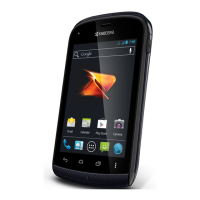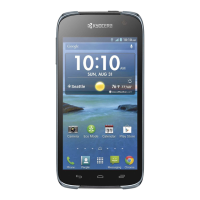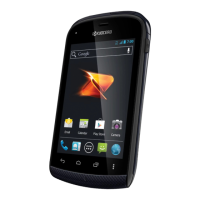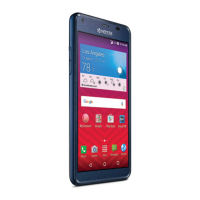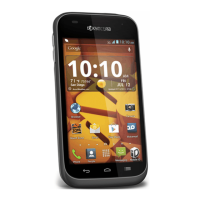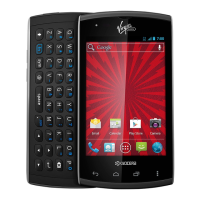Do you have a question about the Kyocera Hydro icon and is the answer not in the manual?
Outlines the phone’s primary external features and buttons.
Instructions for installing and charging the battery to begin setting up the phone.
Guide to setting up a Boost Mobile account and choosing a plan.
Instructions on how the phone activates automatically or manually.
Accessing account information like minutes, Re-Boost, and plan changes.
Illustrations and descriptions of the phone’s basic external layout.
Explains the purpose of various phone components like LED indicator, sensors, and buttons.
How the receiver transmits sound through vibrations on the phone's display.
How to open options for an item by touching and holding it.
How to drag your finger vertically or horizontally across the screen.
How to press, hold, and move your finger with pressure on the screen.
How to swipe your finger in light, quick strokes on the screen.
How to change screen orientation from portrait to landscape.
How to zoom in or out on a picture or Web page using fingers.
Explains Easy mode and Standard mode options for the phone's home screen.
The Android experience for users familiar with the interface, with extended screens.
Simplified experience for first-time users, with three home screens.
How to add, move, or remove icons and widgets from home screens.
Steps to add app shortcuts or widgets from the favorites tray or empty areas.
How to move items to new areas or remove them by dragging to "X Remove".
Steps to open the launcher screens to view apps and widgets.
How to drag and drop apps to rearrange them on launcher screens.
Explanation of icons displayed in the status bar for network, battery, etc.
Icons indicating notifications like GPS active, missed calls, and new emails.
Offers a choice of keyboards like Google Keyboard and Swype for text input.
Visual guide to the Swype keyboard interface and its functions.
Detailed instructions on how to use Swype for text input.
How to enter text, symbols, and numbers using the Google Keyboard.
Step-by-step guide to using voice input for text entry.
Customizing language and blocking offensive words for voice typing.
Overview of convenient ways to place calls from the phone.
The traditional method of placing calls using the phone's dialer screen.
How to quickly place calls to recent incoming, outgoing, or missed numbers.
Placing calls directly from entries saved in the Contacts list.
How to call a number directly from a text or email message.
How to place calls to 9-1-1, even with the screen locked.
Dialing numbers with pauses for automated systems like voicemail.
How to make international calls using the plus code dialing feature.
Making and receiving calls via an Internet calling account over Wi-Fi.
Options for using Internet calling for calls when data network is available.
How to answer, mute, or reject incoming calls.
Overview of the phone's voicemail service, including traditional and visual options.
Setting up Visual Voicemail, similar to traditional voicemail setup.
Onscreen options available during an active call, like Add call and End call.
How to view the recent calls list and determine call types.
Options for making calls, sending texts, or adding contacts from recent calls.
Adjusting voicemail provider or access settings.
Basics of using the People app and understanding contact types.
Different ways to display the Contacts list on the phone.
Options like speed dial, import/export, and settings for contacts.
Using the Edit contact menu to modify contact details.
Assigning a picture stored on the phone or SD card to a contact.
Registering up to five emergency contacts for ICE information.
Needing a Google Account for access to Google apps like Gmail, Maps, and Play.
Creating a Google Account online or directly on the phone.
Logging into an existing Google Account on the phone.
Accessing personal Gmail account directly on the phone.
Adding personal email accounts like POP3 and IMAP from settings.
Setting up email accounts directly from the Email application.
Synchronizing with a corporate account for email access.
Accessing and viewing the email inbox.
Manually synchronizing sent and received email messages.
How to delete individual email messages from the inbox.
Adding slides with pictures, videos, or audio to a multimedia message.
Opening and reading text messages or message threads.
Posting updates, uploading pictures, and accessing Facebook on the go.
Accessing the YouTube application on the phone.
Playing videos on YouTube, with controls for pausing and rewinding.
Finding videos on YouTube by entering keywords in the search box.
Finding and downloading Android apps, books, movies, and music.
Installing apps from Google Play, with terms of service and app details.
Setting up a Google Wallet account for purchasing items on Google Play.
Additional menu options within the Google Play Store app.
Activating the phone's GPS location feature for location-based services.
Activating GPS location for Google Maps and other services.
Navigating maps, zooming, and finding current location.
Browsing, shopping, and playing music from Google Play or your library.
Selecting and installing available ID Packs for customization.
Providing wireless Internet access over distances up to 300 feet.
Enabling Wi-Fi and connecting to available Wi-Fi networks.
How the tool enhances data experience by connecting to remembered Wi-Fi networks.
Turning on the Connections Optimizer feature via settings.
Turning off the Connections Optimizer feature by unchecking a box.
Provides wireless Internet access with high data transfer rates.
Entering credentials or installing certificates for VPN connection.
Downloading and installing security certificates from an SD card.
Adding a VPN connection to the phone through wireless settings.
Opening the browser by touching its icon for Internet access.
Dragging up and down to see content on websites.
Touching items or links on the screen to select them.
Using fingers to zoom in or out on a Web page.
Touching the back icon to return to previous pages or history.
Entering a URL in the address field to visit a specific website.
Enabling or disabling the Lumen toolbar via settings.
Customizing the Lumen Toolbar according to personal needs and style.
Accessing the browser menu from any open Web page.
Creating bookmarks from the History or Saved Pages tabs.
Selecting a previously visited page to display as the home page.
Adding Web bookmarks to the phone's home screen for quick access.
Activating the portable Wi-Fi hotspot service through settings.
Connecting other devices to the phone's Wi-Fi hotspot.
How to take pictures using the phone's camera.
Opening the camera app from the applications list or lock screen.
Closing the camera application using onscreen buttons.
Opening the Gallery app and viewing pictures organized by albums.
Accessing and viewing all stored pictures and videos from the Gallery.
Options for deleting, slideshow, editing, rotating, cropping, and printing pictures.
Using built-in tools to alter pictures after they are taken.
Sending pictures, videos, or both as email attachments.
Creating and managing events, meetings, and appointments.
Adding events directly to the calendar from the application.
Inviting guests to an event via email invitations using your Google Account.
How the phone alerts you to scheduled events with sounds or vibrations.
Viewing, dismissing, or snoozing upcoming event reminders.
Viewing events in a daily list or chronological agenda.
Displaying a chart of the events for one week.
Removing the check mark to stop synchronization for a specific Google calendar.
Adding previously removed calendars back for synchronization.
Accessing the clock app and switching between its functions.
Configuring clock style, home clock, silence, snooze, and volume settings.
Dimming the screen for better visibility when needed.
Creating a new alarm, setting time, label, repeat days, ringtone, and vibrate.
Removing an alarm from the list.
Starting, pausing, resuming, and ending voice recordings.
Playing saved voice data with options for rewind, fast forward, and sharing.
Managing recorded voice data, including sharing, deleting, and editing names.
Using voice recognition to dial numbers or launch phone functions.
Enabling or disabling the phone's Bluetooth capabilities via the settings menu.
Disconnecting from a paired Bluetooth device.
Making the phone forget its pairing connection with a device.
Sending images, videos, or contacts via Bluetooth.
Receiving files like pictures, music, and documents via Bluetooth.
Enabling or disabling NFC capabilities through the settings menu.
Inserting a compatible microSD card into the phone.
Updating the phone's software using the Update firmware option.
Turning Wi-Fi on/off, setting up networks, and configuring advanced options.
Steps to access the Wi-Fi settings for scanning and adding networks.
Setting up and managing wireless access points with advanced options.
Steps to access the menu for Bluetooth controls and information.
Turning NFC capabilities on or off via the settings menu.
Turning on the phone's mobile data access via settings.
Receiving broadcast SMS messages for public warnings and changing alert options.
Provides an easier user experience for first-time smartphone users.
Provides a conventional layout for apps and widgets on home screens.
Setting volume levels for media, ringtones, notifications, and alarms.
Assigning a ringtone to incoming calls.
Configuring the vibrate pattern for ringtones and notifications.
Adjusting screen brightness to suit surroundings or automatically.
Viewing the phone's internal storage capability and available space.
Changing the primary storage location between Phone and SD card.
Viewing card size, unmounting, and formatting the SD card.
Creating a screen lock (pattern, PIN, password) for phone security.
Setting the screen lock to Swipe for quick access.
Unlocking the phone by capturing and recognizing your face.
Adding widgets from the list to the start screen.
Removing widgets from the start screen by dragging them to "Remove".
Encrypting phone and SD card data, requiring PIN or password.
Viewing the supported credentials storage types.
Viewing the trusted credentials stored on the phone's system.
Installing encrypted certificates from the SD card.
Removing all stored credentials from the phone.
Selecting onscreen language and adding custom words to the user dictionary.
Enabling spell checking for text as it is typed.
Adding words to a personal dictionary to improve word suggestion.
Setting backup options and restoring backed-up data.
Resetting the phone to original factory settings, erasing all data.
Setting up new accounts like Corporate, Google, or Email.
Managing settings and syncing options for existing accounts.
Providing spoken feedback for visually impaired users.
Customizing language and style of displayed captions.
Zooming in and out by triple-tapping the screen.
Displaying network provider and IP address information.
Displaying battery status, phone number, network, and signal strength.
Viewing important license and legal information.
Viewing regulatory information related to the phone.
Outlines the phone’s primary external features and buttons.
Instructions for installing and charging the battery to begin setting up the phone.
Guide to setting up a Boost Mobile account and choosing a plan.
Instructions on how the phone activates automatically or manually.
Accessing account information like minutes, Re-Boost, and plan changes.
Illustrations and descriptions of the phone’s basic external layout.
Explains the purpose of various phone components like LED indicator, sensors, and buttons.
How the receiver transmits sound through vibrations on the phone's display.
How to open options for an item by touching and holding it.
How to drag your finger vertically or horizontally across the screen.
How to press, hold, and move your finger with pressure on the screen.
How to swipe your finger in light, quick strokes on the screen.
How to change screen orientation from portrait to landscape.
How to zoom in or out on a picture or Web page using fingers.
Explains Easy mode and Standard mode options for the phone's home screen.
The Android experience for users familiar with the interface, with extended screens.
Simplified experience for first-time users, with three home screens.
How to add, move, or remove icons and widgets from home screens.
Steps to add app shortcuts or widgets from the favorites tray or empty areas.
How to move items to new areas or remove them by dragging to "X Remove".
Steps to open the launcher screens to view apps and widgets.
How to drag and drop apps to rearrange them on launcher screens.
Explanation of icons displayed in the status bar for network, battery, etc.
Icons indicating notifications like GPS active, missed calls, and new emails.
Offers a choice of keyboards like Google Keyboard and Swype for text input.
Visual guide to the Swype keyboard interface and its functions.
Detailed instructions on how to use Swype for text input.
How to enter text, symbols, and numbers using the Google Keyboard.
Step-by-step guide to using voice input for text entry.
Customizing language and blocking offensive words for voice typing.
Overview of convenient ways to place calls from the phone.
The traditional method of placing calls using the phone's dialer screen.
How to quickly place calls to recent incoming, outgoing, or missed numbers.
Placing calls directly from entries saved in the Contacts list.
How to call a number directly from a text or email message.
How to place calls to 9-1-1, even with the screen locked.
Dialing numbers with pauses for automated systems like voicemail.
How to make international calls using the plus code dialing feature.
Making and receiving calls via an Internet calling account over Wi-Fi.
Options for using Internet calling for calls when data network is available.
How to answer, mute, or reject incoming calls.
Overview of the phone's voicemail service, including traditional and visual options.
Setting up Visual Voicemail, similar to traditional voicemail setup.
Onscreen options available during an active call, like Add call and End call.
How to view the recent calls list and determine call types.
Options for making calls, sending texts, or adding contacts from recent calls.
Adjusting voicemail provider or access settings.
Basics of using the People app and understanding contact types.
Different ways to display the Contacts list on the phone.
Options like speed dial, import/export, and settings for contacts.
Using the Edit contact menu to modify contact details.
Assigning a picture stored on the phone or SD card to a contact.
Registering up to five emergency contacts for ICE information.
Needing a Google Account for access to Google apps like Gmail, Maps, and Play.
Creating a Google Account online or directly on the phone.
Logging into an existing Google Account on the phone.
Accessing personal Gmail account directly on the phone.
Adding personal email accounts like POP3 and IMAP from settings.
Setting up email accounts directly from the Email application.
Synchronizing with a corporate account for email access.
Accessing and viewing the email inbox.
Manually synchronizing sent and received email messages.
How to delete individual email messages from the inbox.
Adding slides with pictures, videos, or audio to a multimedia message.
Opening and reading text messages or message threads.
Posting updates, uploading pictures, and accessing Facebook on the go.
Accessing the YouTube application on the phone.
Playing videos on YouTube, with controls for pausing and rewinding.
Finding videos on YouTube by entering keywords in the search box.
Finding and downloading Android apps, books, movies, and music.
Installing apps from Google Play, with terms of service and app details.
Setting up a Google Wallet account for purchasing items on Google Play.
Additional menu options within the Google Play Store app.
Activating the phone's GPS location feature for location-based services.
Activating GPS location for Google Maps and other services.
Navigating maps, zooming, and finding current location.
Browsing, shopping, and playing music from Google Play or your library.
Selecting and installing available ID Packs for customization.
Providing wireless Internet access over distances up to 300 feet.
Enabling Wi-Fi and connecting to available Wi-Fi networks.
How the tool enhances data experience by connecting to remembered Wi-Fi networks.
Turning on the Connections Optimizer feature via settings.
Turning off the Connections Optimizer feature by unchecking a box.
Provides wireless Internet access with high data transfer rates.
Entering credentials or installing certificates for VPN connection.
Downloading and installing security certificates from an SD card.
Adding a VPN connection to the phone through wireless settings.
Opening the browser by touching its icon for Internet access.
Dragging up and down to see content on websites.
Touching items or links on the screen to select them.
Using fingers to zoom in or out on a Web page.
Touching the back icon to return to previous pages or history.
Entering a URL in the address field to visit a specific website.
Enabling or disabling the Lumen toolbar via settings.
Customizing the Lumen Toolbar according to personal needs and style.
Accessing the browser menu from any open Web page.
Creating bookmarks from the History or Saved Pages tabs.
Selecting a previously visited page to display as the home page.
Adding Web bookmarks to the phone's home screen for quick access.
Activating the portable Wi-Fi hotspot service through settings.
Connecting other devices to the phone's Wi-Fi hotspot.
How to take pictures using the phone's camera.
Opening the camera app from the applications list or lock screen.
Closing the camera application using onscreen buttons.
Opening the Gallery app and viewing pictures organized by albums.
Accessing and viewing all stored pictures and videos from the Gallery.
Options for deleting, slideshow, editing, rotating, cropping, and printing pictures.
Using built-in tools to alter pictures after they are taken.
Sending pictures, videos, or both as email attachments.
Creating and managing events, meetings, and appointments.
Adding events directly to the calendar from the application.
Inviting guests to an event via email invitations using your Google Account.
How the phone alerts you to scheduled events with sounds or vibrations.
Viewing, dismissing, or snoozing upcoming event reminders.
Viewing events in a daily list or chronological agenda.
Displaying a chart of the events for one week.
Removing the check mark to stop synchronization for a specific Google calendar.
Adding previously removed calendars back for synchronization.
Accessing the clock app and switching between its functions.
Configuring clock style, home clock, silence, snooze, and volume settings.
Dimming the screen for better visibility when needed.
Creating a new alarm, setting time, label, repeat days, ringtone, and vibrate.
Removing an alarm from the list.
Starting, pausing, resuming, and ending voice recordings.
Playing saved voice data with options for rewind, fast forward, and sharing.
Managing recorded voice data, including sharing, deleting, and editing names.
Using voice recognition to dial numbers or launch phone functions.
Enabling or disabling the phone's Bluetooth capabilities via the settings menu.
Disconnecting from a paired Bluetooth device.
Making the phone forget its pairing connection with a device.
Sending images, videos, or contacts via Bluetooth.
Receiving files like pictures, music, and documents via Bluetooth.
Enabling or disabling NFC capabilities through the settings menu.
Inserting a compatible microSD card into the phone.
Updating the phone's software using the Update firmware option.
Turning Wi-Fi on/off, setting up networks, and configuring advanced options.
Steps to access the Wi-Fi settings for scanning and adding networks.
Setting up and managing wireless access points with advanced options.
Steps to access the menu for Bluetooth controls and information.
Turning NFC capabilities on or off via the settings menu.
Turning on the phone's mobile data access via settings.
Receiving broadcast SMS messages for public warnings and changing alert options.
Provides an easier user experience for first-time smartphone users.
Provides a conventional layout for apps and widgets on home screens.
Setting volume levels for media, ringtones, notifications, and alarms.
Assigning a ringtone to incoming calls.
Configuring the vibrate pattern for ringtones and notifications.
Adjusting screen brightness to suit surroundings or automatically.
Viewing the phone's internal storage capability and available space.
Changing the primary storage location between Phone and SD card.
Viewing card size, unmounting, and formatting the SD card.
Creating a screen lock (pattern, PIN, password) for phone security.
Setting the screen lock to Swipe for quick access.
Unlocking the phone by capturing and recognizing your face.
Adding widgets from the list to the start screen.
Removing widgets from the start screen by dragging them to "Remove".
Encrypting phone and SD card data, requiring PIN or password.
Viewing the supported credentials storage types.
Viewing the trusted credentials stored on the phone's system.
Installing encrypted certificates from the SD card.
Removing all stored credentials from the phone.
Selecting onscreen language and adding custom words to the user dictionary.
Enabling spell checking for text as it is typed.
Adding words to a personal dictionary to improve word suggestion.
Setting backup options and restoring backed-up data.
Resetting the phone to original factory settings, erasing all data.
Setting up new accounts like Corporate, Google, or Email.
Managing settings and syncing options for existing accounts.
Providing spoken feedback for visually impaired users.
Customizing language and style of displayed captions.
Zooming in and out by triple-tapping the screen.
Displaying network provider and IP address information.
Displaying battery status, phone number, network, and signal strength.
Viewing important license and legal information.
Viewing regulatory information related to the phone.
| Brand | Kyocera |
|---|---|
| Model | Hydro icon |
| Category | Cell Phone |
| Language | English |
